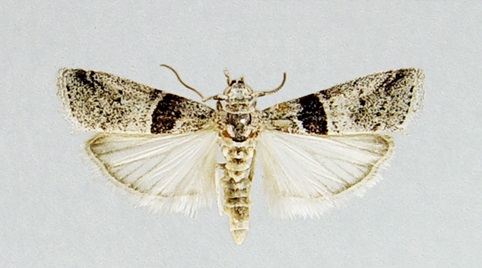Abstract
Elegia species deposited in the Hayk Mirzayans Insect Museum (HMIM) were examined and three species were identified. Elegia kharazii sp. nov. is described based on a single male and two females collected in Gilan and Golestan Provinces, Iran and compared with the externally similar European species E. similella (Zincken, 1818). Elegia saecula Kemal, Kýzýldað & Koçak, 2020 (syn. nov.) is considered as a junior synonym of Elegia iozona (Meyrick, 1937). Elegia atrifasciella Ragonot, 1887, collected in the north-west Iran (East Azarbaijan Province), is a new species for the fauna of Iran.
References
Amsel, H.G. (1953) Neue Kleinschmetterlinge aus Nordwest-Afrika. Bulletin de l‘Institut Français d‘Afrique Noire, Série A: Sciences Naturelles, Dakar, 15 (4), 1441–1460.
Clarke, J.F.G. (1941) The preparation of slides of the genitalia of Lepidoptera. Bulletin of the Brooklyn Entomological Society, 36, 149–161.
Huertas-Dionisio, M., Gastón, J., Ylla, J. & Macià, R. (2016) El género Elegia Ragonot, 1887 en la Península Ibérica (Lepidoptera: Pyralidae, Phycitinae). SHILAP Revista de lepidopterología, 44 (175), 407–431.
Kemal, M., Kýzýldað, S. & Koçak, A.Ö. (2020) Descriptions of new species of the genus Elegia from Turkey (Lepidoptera, Pyraloidea). Centre for Entomological Studies Ankara, Miscellaneous papers, 206, 1–8.
Kristensen, N.P. (2003) Skeleton and muscles: adults. In: Kristensen, N.P. (Ed.), Lepidoptera: Moths and Butterflies. Vol. 2. Morphology, Physiology, and Development, The Handbook of Zoology/ Handbuch der Zoologie. 4/36. Walter de Gruyter, Berlin and New York, pp. 39–131. https://doi.org/10.1515/9783110893724.39
Meyrick, E. (1936–1937) Exotic Microlepidoptera. Taylor and Francis, London, 160 pp.
Nuss, M., Landry, B., Mally, R., Vegliante, F., Tränkner, A., Bauer, F., Hayden, J., Segerer, A., Schouten, R., Li, H., Trofimova, T., Solis, M.A., De Prins, J. & Speidel, W. (2003–2020) Global Information System on Pyraloidea. Available from: http://www.pyraloidea.org (accessed 9 May 2021)
Obenberger, J. (1964) Entomologie V. (Trichoptera, Lepidoptera, Diptera). Nakladatelství ČSAV, Praha, 776 pp.
Plant, C.W., Beshkov, S. & Nahirnić, A. (2020) A new species of Elegia (Lepidoptera, Pyralidae, Phycitinae) from the Balkan Peninsula. Nota lepidopterologica, 43, 311–318. https://doi.org/10.3897/nl.43.54508
Ragonot, E.L. (1887) Diagnoses d’espèces nouvelles de Phycitidae d’Europe et des Pays limitrophes. Annales de la Société Entomologique de France, Paris, Series 6, 7 (3), 225–260.
Robinson, G.S. (1976) The preparation of slides of Lepidoptera genitalia with special reference to the Microlepidoptera. Entomologist’s Gazette, 27, 127–132.
Roesler, R.-U. (1988) Untersuchungen zur Taxonomie paläarktischer Phycitinae (Lepidoptera, Pyraloidea). Beiträge zur Entomologie, Berlin, 38, 65–73.
Slamka, F. (2019) Pyraloidea of Europe (Lepidoptera). Vol. 4. Phycitinae. Part 1. František Slamka, Bratislava, 432 pp.
Staudinger, O. (1881) Lepidopteren-Fauna klein-Asien’s. Horae Societatis Entomologicae Rossicae, 16, 65–135.
Zincken, J.L.T.F. (1818) Die Lineeischen Tineen in ihre natürlichen Gattungen aufgelöst. Magazin der Entomologie, Halle, 3, 113–176.


